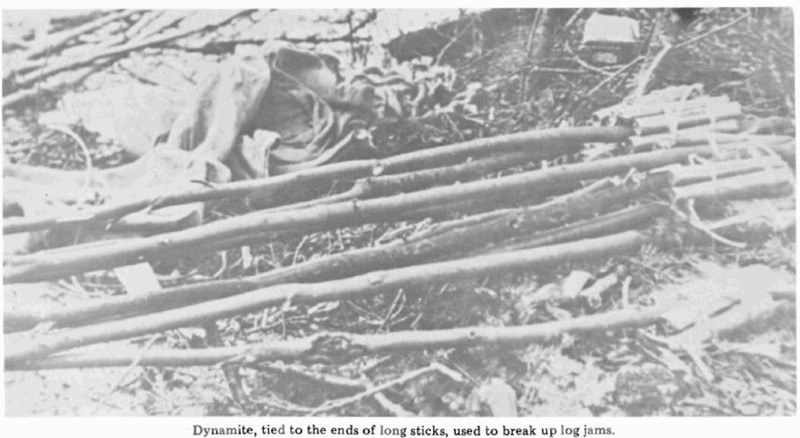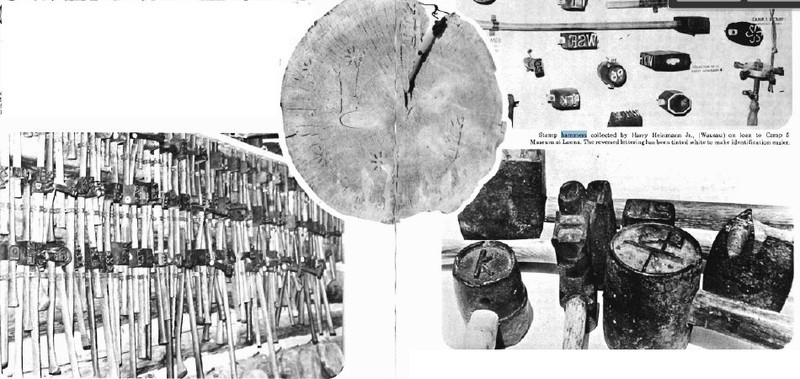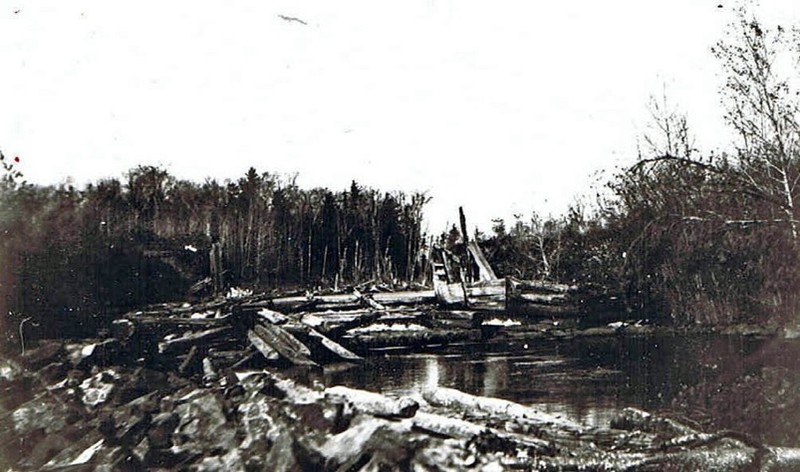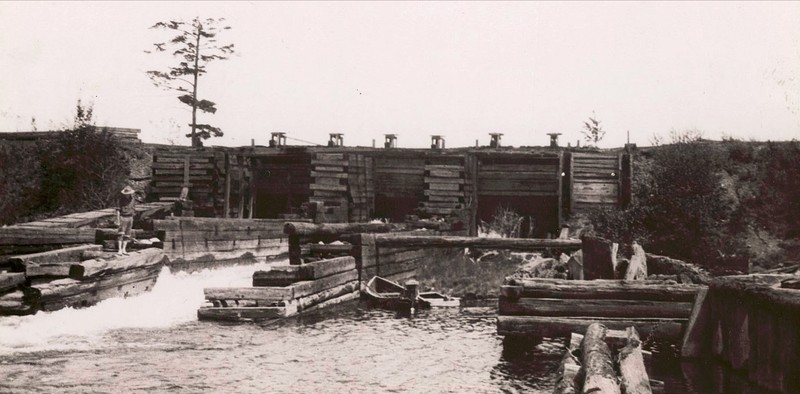Log Boom on Sturgeon Rapids
Introduction
Text-to-speech Audio
Just above Sturgeon Lake, the Manitowish River narrows into a shallow rapids that proved vexing to river drive loggers from the 1880s until about 1910. Each spring. the mighty force of the waters behind Rest Lake Dam were released to move white pine logs hundreds of miles to massive sawmills. After the ice melted in April, paddle boats rafted logs to just above Rest Lake Dam, and when the sluices on the dam were opened, millions of feet of fresh cut timbers were sent down stream. Unfortunately, the first mile of the Manitowish River below Rest Lake has several dogleg turns and rapids that frequently created troublesome jams. Ultimately, logging companies installed a log boom on Sturgeon Rapids to easily separate white pine logs before they jammed; otherwise, dynamite on a stick was the typical solution..
This important site can be accessed by water or on state land to the north of the Manitowish River. The land to the south of Sturgeon Rapids is private, which should be respected by all travelers. The North Lakeland Discovery Center maintains a trail under a DNR Land Use Agreement that connects hikers, bikers, skiers and snowshoers to the high bank right above Sturgeon Rapids. In the winter, the water stays open and attracts eagles, swans and other wildlife. Evening hikers following the trail downstream can also enjoy the sunset.
Images
Dynamite on a stick was used to blast jams apart

Heavy stamp hammers were used to mark the butt ends of white pine logs to credit the logging company at sawmills

Sturgeon Rapids log jam and log boom on the Manitowish River


1911 Rest Lake Dam with center sluice open and gears to lift sluice gates on top of the dam

Backstory and Context
Text-to-speech Audio
Most logging practices used in Wisconsin were developed in New England. Logging companies and logging families followed the timber west along the Great Lakes. Wisconsin's dense and far-reaching stands of timber were prized by land companies, speculators, loggers and even universities. Most folks do not realize that much of New York's Cornell University was initially paid for with profits from white pine logs along Wisconsin's Chippewa River. The Morrill Land Grant Act of 1862 gave agricultural universities (like Cornell) land to help develop agri-science programs. Cornell used shrewd business tactics to acquire 499,000 acres of prime white pine lands that stretched up the Manitowish River.
Modern scholars divide logging and lumber industries into three different phases:
1) river drives of white pines
2) railroad logging and harvesting the remaining white pines, red pine, hardwoods and other trees; and
3) post-WWI small logging camps, using trucks and tractors
The log boom on Sturgeon Rapids was created to facilitate Phase 1 white pine logging. Log drives were notorious for losing logs along the drives. White pines, sometimes referred to as "cork pines," were the only Northwoods species of trees that would float through the entire downstream journey. Even experienced log drivers, called "River Pigs," lost at least 10 percent of their logs along the journey. Log drives ranged from small family operations to huge corporate projects. Frederick Weyerhaeuser and his syndicate of corporations dominated river drive logging along the Manitowish River. In April of 1901, the largest log drive ever on the Chippewa River began at the Rest Lake Dam under Weyerhaeuser's leadership. That drive saw 150 River Pigs and support staff push 75 million feet of timber downstream. Imagine the challenges that Sturgeon Rapids and the doglegs in the river posed. It took the winters of 1900 and 1901 to cut and stage the white pines.
By 1915, river drive logging had become rare, and railroads were mostly in charge of moving timber to market. The DNR removed the old remnants of the logging boom from the Manitowish River by the 1970s. Logging heritage is strong in the Manitowish Waters area representing all three phases of Wisconsin logging. Sturgeon Rapids remains a unique logging heritage site that is easily accessed by water or trail.
Sources
Benard, W D. Rest Lake Dam, Univeristy of Wisconsin-Madison. Invalid date. Accessed December 5th, 2022. https://search.library.wisc.edu/digital/ASK6SLCHV4ROYD8S.
Gates, Paul Wallace . The Wisconsin Pine Lands of Cornell University. Madison , WI. The State Historical Society of Wisconsin, 1943.
Harmon, John. "Largest Log Drive Saved by Camp Cook." Chippewa Herald-Telegram (Chippewa Falls) February 3rd, 1997.
Rosholt, Malcolm. Lumbermen on the Chippewa, McMillan Memorial Library Local History. April 8th, 2022. Accessed December 4th, 2022. https://content.mpl.org/digital/collection/mcml/id/3757/rec/5.
Rosholt, Malcom. The Wisconsin logging book, 1839-1939, McMillan Memorial Library. April 8th, 2022. Accessed December 4th, 2022. https://content.mpl.org/digital/collection/mcml/id/4532/.
Rosholt, M. 1980. “The Wisconsin Logging Book, 1839-1939.” 1980. https://content.mpl.org/digital/collection/mcml/id/4532/.
Rosholt, M. 1980. “The Wisconsin Logging Book, 1839-1939.” 1980. https://content.mpl.org/digital/collection/mcml/id/4532/.
Manitowish Waters Historical Society
Benard, W D. Rest Lake Dam, Univeristy of Wisconsin-Madison. Invalid date. Accessed December 5th, 2022. https://search.library.wisc.edu/digital/ASK6SLCHV4ROYD8S.
